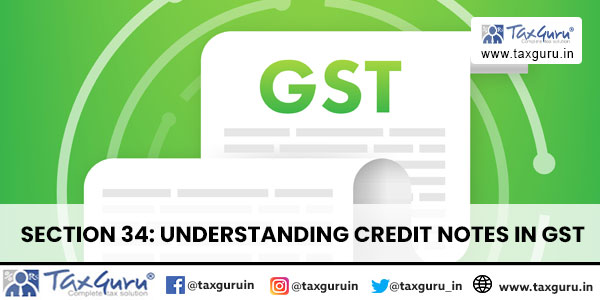Section 34 of the GST Act outlines the provisions related to credit notes, an essential tool for adjusting invoice values under specific circumstances. A credit note is issued by a registered supplier to reduce the taxable value or correct discrepancies in the original invoice. Common scenarios for issuing a credit note include errors in the taxable value, charging higher tax rates than applicable, or situations where goods or services are returned by the recipient due to defects or rejection. Credit notes ensure accurate tax reporting by reducing the supplier’s output tax liability and the recipient’s input tax credit (ITC).
There is no legal restriction on the time of issuing a credit note; however, it must be reported in GST returns within a specified period, typically by November 30 of the following financial year or the filing date of the annual return (GSTR-9), whichever comes earlier. Failure to report within this timeframe necessitates issuing a commercial credit note, which does not involve GST adjustments. Credit notes are applicable to taxable, exempt, and nil-rated supplies and must be carefully linked to the original invoice for compliance purposes. Proper reporting of credit notes in forms like GSTR-3B ensures alignment with GST regulations, making them a critical aspect of tax management.

1. Meaning of Credit note: It will be issued for reduction in the value of invoice due to number of reasons.
2. Circumstances for issuing of a credit note:
a. Actual value of supply of goods or services supplied is lesser than the value reported in the invoice.
Example:-
Actual value of goods or services supplied is Rs 10,000 & GST rate is 18%.
In the tax invoice, supplier mentioned taxable value 1,00,000 & charged GST accordingly.
Now, he will raise the credit note of Rs 90,000 and charged the GST 1,800.
b. Tax charged in the invoice is more than the actual liability.
Example:
Actual value of goods or services supplied is Rs 1,00,000 & GST rate is 18%.
In the tax invoice, supplier mentioned Taxable value 1,00,000 & charged GST @28%.
Now, he will raise the credit note of Rs 10,000 for adjustment of GST or he can amend the original invoice.
c. The recipient returns the goods or services.
d. The recipient returns the goods or services due to defect in the products or wrong product delivered or rejection of services.
c. Any other similar reasons.
3. Authority for issuing of a credit note:
a. Only registered supplier under GST can issue credit note to the recipient to whom goods or services supplied.
b. Recipient cannot issue credit note under GST Act.
4. Time limit for issuing:
As per GST Act, there is no time limit for issuing of credit note. Whenever situations arises, supplier can issue credit note to the recipient but there is a time limit for reporting in GST return.
5. Time limit for reporting in return:-
Credit note should be reported in GST till a specified period & this period will be determined on the basis of actual date of invoice against which credit note was issued.
a. 30th November of next financial year
Or
b. Date of filing of GSTR-9
Whichever is earlier.
Example:
Date of invoice is 15-05-2024, credit note against this invoice can be reported in GST upto 30th Nov 2025 or date of filing of GSTR-9 of the FY 24-25 whichever is earlier. After this period, credit note cannot be reported in return.
6. Nature of supplies:
- It can be issued for taxable supplies.
- It can be issued for exempt supplies.
- It can be issued for nil rated supplies.
7. Treatment in Supplier return:
After issuing of a credit note, output liability of the supplier will be decreased.
8. Treatment in recipient return:
After issuing of a credit note by supplier, ITC of the recipient will be reduced.
In case of a credit note, output liability & ITC of the supplier & recipient will always decrease, respectively.
9. Reporting in GSTR-3B:
a. Import of goods:- The credit note will be reported in table-4A(1) of GSTR-3b if it relates to invoices associated with the import of goods.
b. Import of services:- The credit note will be reported in table-4A(2) of GSTR-3b if it relates to invoices associated with the import of services.
c. RCM:-
The credit note will be reported in table-4A(3) of GSTR-3b if it relates to invoices associated with the RCM transactions other than import of services.
d. ISD:- The credit note will be reported in table-4A(4) of GSTR-3b if it relates to invoices associated with the credit note issued by ISD.
e. Forward charge invoices:- The credit note will be reported in table-4A(5) of GSTR-3b if it related to invoices associated with on which GST is charged under FCM.
Credit note will not be reported in Table-4B(2). It should always be report in Table-4A.
10. Linking with original invoice:
a. If invoice was issued in the FY 23-24 & CN was issued in the month of March 2025 then time period of reporting of this CN will be 30th November 2024 or date of filing of GSTR-9 i.e annual return whichever is earlier. Hence, this credit note cannot be reported in GST because time period of reporting has been expired.
b. Time period for reporting of CN is depend on the date of invoice when it was issued not when the credit note was issued.
Hence, there is a link between credit note & invoice for the purpose of reporting in return.
11. Commercial credit note:- In case of expiry of time period, in that cases supplier cannot report CN in return. Hence, he will issue the commercial credit note without charging the GST & these CN will not be reported in GST.
*****
In case of any queries you may reach out to me at caashishsingla878@gmail.com.
Disclaimer: The views & opinions expressed in this article are solely those of the author. The contents of this article are solely for informational purpose. It does not constitute professional advice or recommendation. Readers should consult with a qualified professional or tax advisor before making any decisions based on the content of this article. Author will not accepts any liabilities for any loss or damage of any kind arising out of any information in this article nor for any actions taken in reliance thereon.






Every credit note should be link with invoice, however it is not required for reporting purpose only.
yes for determining the period of reporting of CN in GST. it is link with the invoice but invoice date will not be reported in credit note table in gst return.